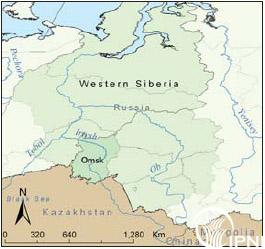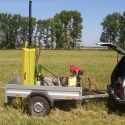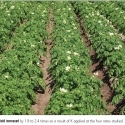17 Dec 2013
Zinc Application Method ImpactsWinter Triticale in Western Siberia
By Igor A. Bobrenko, Natalya V. Goman and Elena Yu. Pavlova

Nowadays, studies on new foodgrain resources and technologies to enhance crop productivity have a great practical signif cance. Improv-ing grain quality of cereals and increasing production of plant protein are considered as the most important goals for Russian agriculture. Mineral fertilizers play a key role in achieving these goals including micronutrient fertilizers that are effective in increasing both grain yield and quality of cereals according to numerous research studies (Bo-brenko et al., 2011a; 2011b). Micronutrients need to be ap-plied at lower rates compared to macronutrients, but have higher requirements regarding their uniformity of application.
Winter triticale is a very promising cereal crop for Russia. Triticale grain has higher level of lysine than winter wheat. Lysine is an essential amino acid in human nutrition and plant proteins usually have insuff cient levels of lysine. Bak-ing properties of triticale are not as good as soft wheat, but its characteristics may be successfully used for baking of so-called “white rye” bread and pastries made from unleavened dough—when gluten quality is less important than nutritional value (Sechnyak and Sulima, 1984).
Omsk Oblast is a second largest agricultural region in Western Siberia, after Altai Krai. Arable soils in Omsk Oblast are very often def cient in available Zn according to soil fertility surveys. A low level of available Zn was revealed in 2.9 million ha, or 99% of the arable land comprised by the regional soil survey. Meadow-chernozem soils (Gleyic Chernozems) gener-ally have insuff cient levels of available P; however, high rates of P fertilizers may contribute to Zn def ciency if soil available Zn is low. A balanced application of Zn fertilizers to cereal crops is of high importance to optimize plant nutrition and, hence, to obtain higher yield and quality of grain (Krasnitskiy, 2002). Developing strategies to increase the effectiveness of Zn fertilizer use to winter triticale may be considered as a signif cant goal to enhance crop productivity in the Southern forest-steppe zone of Western Siberia (Krasnitskiy, 1999; Orlova, 2007).
The purpose of this study was to develop the most effective methods and rates of Zn fertilizer application to winter triticale in Omsk Oblast (Southern forest-steppe). This region is char-acterized by average annual rainfalls of 135 mm during the growth period. Research experiments were conducted during 2007-2011 in experimental f elds of the Siberian Research Institute of Agriculture. The region’s meadow-chernozem was a clay loam with medium OM content (6 to 9%). Average initial contents of nitrate-N (NO3-N) and available P (0 to 30 cm soil layer) were medium at 8.0 ppm NO3-N and 4.0 ppm P, respec-tively. The average level of available K was 49 ppm, which falls within the “high” interpretation class. Nitrate, available P and K were extracted with 2% acetic acid (CH3COOH) solu-tion (Ermokhin, 1995). It is important to indicate that avail-able soil Zn extracted with ammonium acetate buffer solution (pH 4.8) was only 0.6 ppm Zn, which falls within the “low” category. Plots were 16 m2 and were replicated three times. Winter triticale (variety Sibirskiy) was preceded by bare fal-low. Fertilizer applications included basal rates of N and K applied as ammonium nitrate and potassium chloride before tillage and a seed-placed P fertilizer as triple superphosphate. We studied two methods of zinc sulfate (ZnSO4) fertilizer ap-plication: 1) basal application before tillage and 2) powdered seed treatment.
Results
During four experimental years, grain yield of winter triti-cale varied from 1.30 to 3.15 t/ha (2.27 t/ha average) in the treatment receiving N fertilizer only (N30) (Table 1). The effect of Zn fertilizer on grain yield was most dependent upon annual weather conditions and Zn rates used. Soil applied Zn rates in addition to N fertilizer improved crop productivity and a signif cant yield increase was revealed during all experimental years. An average yield increase due to basal Zn application at rates of 4 and 8 kg Zn/ha was 0.32 and 0.41 t/ha or 14 and 18%, respectively.
Improved P nutrition resulted in a signif cant yield increase of winter triticale because soil at the site had a medium soil test P. Phosphorus application at 60 kg P2O5/ha gave an aver-age yield increase of 0.64 t/ha or 28% compared to N fertil-izer alone. During the 2008-2009 vegetative season that had both excessive rainfall and cool weather, P application was most effective and generated a considerable yield increase of 0.99 t/ha or 76%. Basal application of Zn fertilizer at rates of 4 and 8 kg Zn/ha in treatments receiving both N and P increased the average grain yield by 0.22 and 0.39 t/ha or by 8 and 13%, respectively. In our experiments, the highest average grain yield of 3.30 t/ha was obtained in the treatment receiving N30P60Zn8. Therefore, the highest grain productivity of winter triticale under these environments can be achieved only through balanced application of N, P and Zn.
During the last two years of study, two more treatments were added to combine a higher basal Zn rate of 12 kg Zn/ha with both N30 and N30P60. However, these failed to increase grain yield beyond that achieved with 8 kg Zn/ha (data not shown). Hence, the optimum rate for basal Zn application to winter triticale grown on meadow-chernozem soil may be recommended as 8 kg Zn/ha.Soil applied Zn fertilizer in addition to N30 had the highest positive effect on grain quality of winter triticale (Table 1). Grain test weight increased from 604 to 639 g/l and grain pro-tein content increased from 16.3 to 16.9% (four-year average) due to basal Zn application at a rate of 8 kg Zn/ha.
Improving P nutrition lessened the effect of basal Zn application on grain quality. Low Falling Numbers (63-64 sec.) for winter triticale variety Sibirskiy generally indicate the high activity of α-amylase enzyme and the accumulation of starch breakdown products in grain that makes bread sticky.
Seed treatment with ZnSO4 powder at rates of 50 and 100 g ZnSO4/100 kg seed was generally less effective compared to soil application of Zn. Seeds covered with ZnSO4 within the N30P60 and N30P60K60 treatments generated average yield in-creases of 2 to 9% and 6 to 8%, respectively (Table 2). A high effectiveness of seed treatment was found in the 2008-2009 growing season with prevailing cool weather and excessive rainfall. For example, N30P60K60 combined with 50 and 100 g ZnSO4/100 kg seed resulted in 0.38 and 0.55 t/ha or 16 and 24% yield gains, respectively.
During the last two years we included an increased Zn rate of 150 g ZnSO4/100 kg seed into the study for both the N30P60 and N30P60K60 treatments; however, no further yield increase was found with this high Zn rate (data not shown). The optimal Zn rate for seed dressing, therefore, may be recommended as 100 g ZnSO4/100 kg seed.
Comparing the average yields in treatments receiving N30P60 and N30P60K60 it can be concluded that K fertilizer has practically no any effect when applied to winter triticale. A positive effect of K fertilizer on grain yield was, nevertheless, revealed in the 2007-2008 season that was characterized by a low snowfall in winter and inadequate precipitation during several months.Seed dressing with ZnSO4 powder in treatments receiving N30P60 and N30P60K60 had a small positive effect on grain qual-ity of winter triticale (Table 2). Nevertheless, the maximum grain protein (17.1%) was formed in the N30P60K60 treatment with Zn seed covering at a rate of 100 g ZnSO4/100 kg seed.
Summary
In conclusion, our results indicate that Zn fertilizer has a signif cant positive effect on both grain yield and quality of winter triticale grown on meadow-chernozem soil in the South-ern forest-steppe zone of Western Siberia. It was revealed that soil applied Zn fertilizer under these environments generally is more effective in increasing grain yield compared to seed treatment. The optimum Zn rates for soil application and seed treatment were found to be 8 kg Zn/ha and 100 g ZnSO4/100 kg seed, respectively.
Dr. Bobrenko is Dean, Faculty of Agrochemistry, Soil Science and Ecol-ogy; e-mail: bobrenko67@mail.ru.
Dr. Goman is Head, Department of Agrochemistry; e-mail: mera@mail.ru.
Ms. Pavlova is M.Sc. student, Department of Agrochemistry; e-mail: www.elena.ru.09@mail.ru. Omsk State Agrarian University, Omsk.
The authors acknowledge Dr. V. Nosov, Director, IPNI Southern and Eastern Russia Region, for his comments and help during the preparation of this article.
References
Bobrenko, I.A., N.V. Goman, V.I. Popova and E.P. Boldysheva. 2011a. Omsk Science Herald, 1 (104): 246-250. (In Russian).
Bobrenko, I.A., V.M. Krasnitskiy, N.V. Goman and V.I. Popova. 2011b. Soil Fertility, 4: 18-19. (In Russian).
Sechnyak, L.K. and Yu.G. Sulima. 1984. Triticale. Moscow, Kolos. 317 p. (In Russian).
Krasnitskiy, V.M. 2002. Agrochemical and ecological characteristics of soil of Western Siberia. Omsk, Omsk State University Printing House. 144 p. (In Russian).Krasnitskiy, V.M. 1999. Agrochemical characteristics and fertility of soils of Omsk Oblast. Omsk, Omsk Printing House. 51 p. (In Russian).
Orlova, E.D. 2007. Microelements in soils and plants of Omsk Oblast and use of microfertilizers. Omsk, Omsk State University Printing House. 76 p. (In Russian).
Ermokhin, Yu.I. 1995. Diagnostics of plant nutrition. Omsk, Omsk Agrarian University Printing House. 208 p. (In Russian).




